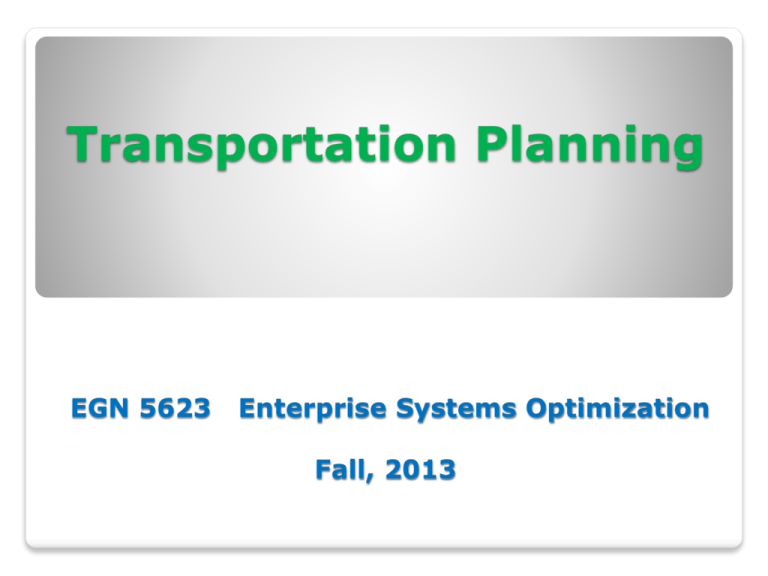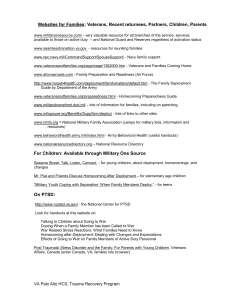
Transportation Planning
EGN 5623
Enterprise Systems Optimization
Fall, 2013
Transportation Planning
Theories & Concepts
EGN 5623
Enterprise Systems Optimization
Fall, 2013
Transportation Planning (Overview)
Objective of Transportation planning:
To group delivery into shipment in order to minimize the
number of shipments and the length of the shipments.
Transportation planning:
• is carried out after delivery note is created in the
sales (fulfillment) process.
• Is executed either automatically several times per day
to deliver in batches, or manually by the
transportation planner.
Purchase
Order
Major Businesses Processes
Purchase
Requisition
Schedule
and Release
Convert Production
Proposal
Procurement
Process
Goods
Issue
Run MPS w/MRP
Sales Order
Production
Check
Entry
ProcessCompletion
Availability
Sales Quotation
Confirmation
Delivery Note/
Entry
pick materials
Sales
Process
Receipt of
Payment
Pack
Materials
Post Goods
Issue
Invoice
Customer
Goods
Receipt
Invoice
Receipt
Payment
to Vendor
F/G Goods
Receipt
Order
Settleme
nt
January 2008
© SAP AG - University Alliances and
The Rushmore Group, LLC 2007. All
rights reserved.
4
TP/VS in SCM (review)
THEORY AND PRACTICE OF ADVANCED PLANNER AND OPTIMIZER IN SUPPLY CHAIN DOMAIN by Sam Bansal
Time Horizons for TP/VS and
Replenishment in SCM (review)
Level of Detail and Time Horizon
of TP/VS and Deployment in APO
Modules (review)
TP/VS and Replenishment Processes in APO
Modules (review)
TP/VS Module in APO System Structure and
Integration with ERP (review)
Overview Master Data and
Application in TP/VS (review)
Transportation Planning Overview
Inputs to transportation planning:
due date of customers’ orders,
customers’ calendar of loading and unloading,
capacity restriction of vehicles,
vehicle availability, and
incompatibility (e.g. of the goods and locations).
TP/VS offers an optimization tool for transportation
planning.
The transportation planning creates “shipments” in APO.
Transportation Planning Overview
After creation of a shipment, the subsequent steps
are
To select a carrier and
to release the shipment.
The shipment is transferred to ERP after it is released
in APO.
Order Life Cycle for Transportation
Planning
Transportation Planning Process in
APO
1.
2.
3.
4.
Create shipments in TP/VS
Assign transportation resource to each shipment
Assign carrier(s) to each shipment
Release shipments
Transportation Planning Overview
The common process flow is to create deliveries in ERP
first before running TP/VS.
TP/VS is designed for transportation planning of a
production or trading company
NOT for a transport service provider since TP/VS
doesn’t cover some of their common functional
requirement but require the master data for
products, location, and resources.
Transportation Planning Overview
TP/VS plans for orders which contain a start location
(LOCFROM) and a destination location (LOCTO).
Inbound documents:
purchase orders
Outbound documents:
delivery notes, sales orders, stock transfer orders,
and return orders.
ERP and APO don’t combine inbound and outbound
orders in one shipment.
Master Data for TP/VS
The main master data for TP/VS are:
locations
manufacturing plant,
distribution centers,
customers,
transportation zone,
transport service provider.
transportation lanes,
means of transport, and
vehicle resources.
Master Data for TP/VS
Master Data for TP/VS
Transportation Zone and Transport Service Providers:
The transportation zones and transport service
providers (carriers) are location types 1005 and 1020,
respectively.
The transportation zone data are stored in Customer
Master data in ERP and are transferred to APO.
The transportation zone is implicit with the customer
and the transport service provider using vendor in
ERP.
TP/VS scheduling methods are predefined in the APO,
as shown in next slide.
Vehicle Scheduling Methods List
(A Hierarchy Structure for TP/VS)
Master Data for TP/VS
Transportation Lanes (routes):
Transportation lanes are defined from plants and DCs
to (customer’s) transportation zone, and are created
manually in APO.
The allowed carriers are assigned per transportation
lane (route) and transportation means explicitly.
The restriction on the validity of a transportation lane
per product is ignored by TP/VS.
Detailed Planning in Transportation
Lane
Vehicle Modelling
The three entities for vehicle modelling are:
Mode (by sea, truck, rail, or air)
Means of transport (speed such as normal or express), and
Vehicle resources
The mode is maintained with the customising path and is
used only for grouping purpose, such as by sea, by air,
by truck.
The means of transport corresponds to speed (normal vs.
express), or shift.
Vehicle resources: vehicle type, category, and capacity
(tonnage T) (e.g. a resource with the capacity of 20 T is
not allowed to load 22 T products.
Entities for Vehicle Modelling
Geo-Coding
The transport duration are computed based on
geo-coding of the locations and
the distance between locations.
The geographical settings of locations are determined by
country and region (standard setting),
postal code, or
street address.
The distance for a transportation lane is estimated as
the air-line distance (standard) or
the actual distance between addresses using a route
planning based on the exact longitude and latitude of
the locations as input.
Geo-coding Combinations for
Scheduling
TP/VS Optimisation
The optimiser creates shipments with the lowest penalty
cost, while meeting all required constraints.
Hard constraints:
compatibilities,
opening hours (modelled by handling resource), and
finiteness
Soft constraints:
earliness and lateness defined in the optimiser profile
The TP/VS optimiser is a mixture of local search and
evolutionary search. For configuration of the optimiser,
the optimiser profile has to be created.
Table 8.1 Costs within the Cost
Profile
Scheduling with Runtime Lanes
In order to generate a schedule with runtime lane, it is
critical to determine the distance of the runtime lanes.
The distance of the runtime lanes is either based on GIS
information or is calculated using the geo-coding distance
and the wiggle factor from the means of transport.
The mean of transport has to have the option ‘GIS quality’
selected and the average speed for city, country road and
motorway have to be maintained, if detailed distance
needs to be calculated with geo-coding.
Scheduling with Runtime Lanes
Carrier Selection
Criteria for selecting carriers:
service-quality-based priority, and
cost.
Carrier selection is performed after the planning for
shipments is done, and before the shipments are
transferred to SAP ERP.
If one stage of transport is already assigned to a carrier
which has the flag for continuous move, the same
carrier is selected for succeeding stage.
Carrier Selection principle
•
Keep the same carrier for continuous move
Deployment Overview
Scope of Deployment
To handle the deviation between demand and supply
happens.
The basic idea of deployment is to convert planned
stock transfers into confirmed stock transfers
according to the available supplies, the demand, the
deployment strategy, and the fair share rule.
If the demand exceeds the supply, it has to be decided
which demand at which location will be covered and to
what extent.
Deployment Overview
The available-to-deploy (ATD)-receipt and ATD-issues are category
groups which are assigned to the location and location product
master.
ATD-receipt:
Stock
Production order for finished goods
Purchase order for raw/trading materials.
ATD-issues:
Deliveries
Confirmed distribution requirements
Safety stock is ignored by deployment. Safety stock is modelled as
a demand in SAP APO, not a supply element.
Deployment Heuristic
The deployment heuristic is a source-location-by-source-location
approach to distribute the ATD quantities. Deployment is either
carried out online in the interactive planning book or in the
background in SAP APO.
For each source location, a separate background deployment
planning run is required (see the figure 12.1).
Deployment is based on short term data and is a step towards
execution.
The deployment horizon defines the maximum horizon for which
orders are ready.
Setting for Deployment Heuristic
Deployment Horizon
The deployment pull horizon defines the horizon for the
relevant requirement (ATD-issues).
The deployment push horizon defines the horizon for relevant
ATD-receipt, e.g. production order (see Figure 12.2).
The deployment focus is the short term, therefore a
distribution requirement that is close to today might ‘steal’ the
ATD-quantities from a distribution requirement further in the
future.
The SNP checking horizon is applied to reduce/eliminate the
deployment need. It takes all issues (e.g. deployment
confirmed distribution requirements) into consideration before
using ATD-receipts for the deployment confirmation of new
requirement (see Figure 12.3).
Deployment Horizons
Deployment Strategy
Pull deployment:
Distribution order is confirmed according to requirement data of
planned distribution orders at the source location.
Pull/Push deployment:
Confirmed distribution orders are scheduled as early as possible.
Push by demand:
Deployment pull horizon is overruled by the planning horizon.
Push by quota arrangement:
All ATD-receipts within the deployment push horizon are shipped
to the target location according to outbound quota of the source
location regardless of requirement in target locations.
Push taking safety stock horizon into account:
Basically like ‘pull/push’, but the ATD quantities used to cover the
safety stock are not deployed immediately and with a delay.
Fair Share
In most cases of a supply network, a source location may
supply to more than one target location. During deployment
planning, the requirements may be processed in the order of
their requirement date, so that shortages affect the
requirements with a later date.
For requirements with the sales due bucket, the fair share
rule defines which requirements are fulfilled and to which
extent.
Rule A: Percentage distribution by demand
Rule B: Same absolute quantity of shortage for target
locations
Rule C: Percentage division by quote arrangement of
source location
Rule D: Division by priority of target locations.
Fair Share Rules A and B
Deployment Optimisation
The structure of deployment optimiser is similar to the SNP
optimisation. Both use the same objects for the optimiser
profile, the cost profile, and cost setting.
The optimiser is able to delete confirmed stock transfers
within the planning horizon.
Fare share strategies of deployment optimiser are:
Rule A: percentage distribution by demand
Rule B: percentage fulfillment of target.
Fair Share Rules
Transport Load Builder (TLB)
The transport load builder is a short term planning tool to
combine confirmed distribution orders to form truckloads or
other transport units according to the capacity restrictions.
The use of TLB is an optional step in distribution and
replenishment planning.
TLB planning follows the deployment run and uses confirmed
distribution orders as input.
Transport Load Builder (TLB)
The TLB procedure is to load all selected deployment orders
according to the restrictions in TLB-profile
Two loading approaches (shown in Figure 12.14)
Straight loading
The procedure for straight loading is in Figure 12.15.
The orders are stored according to the loading group.
The settings to control the procedure for transport load
building are maintained in the transportation lane and in
the product master (see Figure 12.16).
Load balancing:
Distribute the products to be loaded evenly onto
different truck loads
Straight Loading vs Load Balancing
Procedure for Straight Loading
Horizon for TLB
The most important horizons for TLB are:
The TLB planning horizon
TLB planning horizon defines which distribution orders
are taken into account for TLB run.
The TLB pull-in horizon
It defines which orders might be scheduled forward
and is maintained in the transportation lane itself.
It starts from the earliest order, and combine it with
other distribution orders within the TLB pull horizon
(until the capacity is full) (see Figure 12.17).
TLB Horizon
Capacity Restrictions for TLB
The relevant capacity restriction in the TLB profile includes
the following constraints:
Maximum volume,
Maximum weight, and
Maximum number of pallets.
A lower limit exists as well to inhibit uneconomical transport
orders.
Transportation Planning
SAP Implementation
EGN 5623
Enterprise Systems Optimization
Fall, 2013
TP/VS Module in SAP SCM
Note: Strategic network design issues
are not handled by SAP SCM
Transportation Planning Overview
TP/VS planning is performed on the basis of deliveries,
but it allows to plan for sales orders as well.
If TP/VS plans for sales orders, planning is performed
either on the basis of sales orders, sales order items or
schedule line.
Which of these is used depends on the consolidation level
(a setting on the client level) and is maintained with the
customising path:
APO-> TP/VS-> Basic setting -> Basic setting for
vehicle scheduling
TP/VS Planning Board
The central tool for TP/VS planning is the TP/VS planning
board, which is called with the transaction
SAPAPO/VS01.
When the planning board is called, the user needs to
enter an optimization profile, which contains restrictions
on the resources, locations, compatibilities and/or order
types (ATP categories).
The user can perform interactive planning of shipments
on the planning board. There is a consistency check while
saving the shipments (e.g. all relevant stages are
assigned).
The user may create and use heuristics in ‘multi-level
planning’ – view of the planning board.
TP/VS Planning Board
Deployment Relevant Setting in
Product Master
Create Work Area for SCM
Create Locations (Plant, DCs,
Customers, Vendors)
Maintain Means of Transportation in
SCM
Change Inbound Quota
Arrangement
Exercises:
PPM and PDS
1. Setting for PDS in SCM system and create integration model
for PDS transfer
2. Create integration model for PDS SNP transfer
Transfer of transactional data from ERP to SCM
1. Create integration model for planning independent
requirement (PIR)
2. Transfer integration model for planning independent
requirement (PIR) to SCM
Maintain supply chain model in supply chain engineer
1. Maintain supply chain model in SCM system
2. Transportation mode and means






